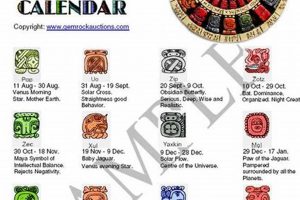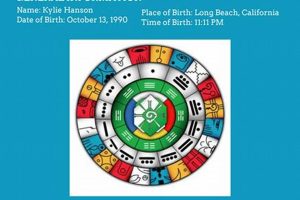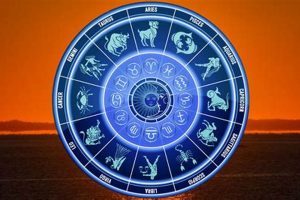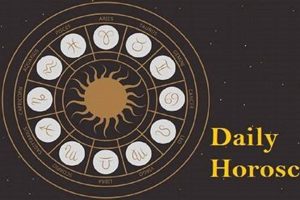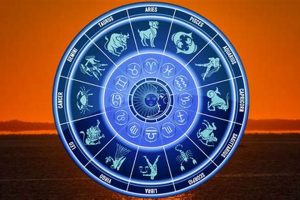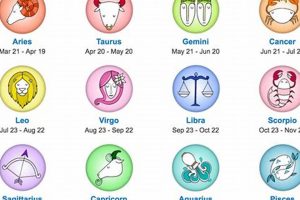The Dreamspell calendar, often associated with Mayan cosmology, is a system distinct from the traditional Mayan calendar. It offers a perpetual 260-day cycle (Tzolkin) interwoven with a 365-day solar year, generating a 52-year cycle known as the Galactic Spin. This system provides daily readings, known as kin, which combine a solar seal (representing an archetype) with a tone number (representing a stage of action or creation). Users consult this system for self-reflection, understanding cycles of energy, and exploring potential influences on personal growth.
Proponents value this tool for its potential to facilitate self-discovery and awareness of cyclical patterns in life. While drawing inspiration from Mayan concepts of time and cosmology, it’s essential to distinguish this contemporary interpretation from traditional Mayan calendrical practices. The Dreamspell calendar, developed by Jos Argelles (Valum Votan), emerged in the late 20th century and represents a modern synthesis aimed at personal and planetary transformation.
Further exploration of this system can involve examining the meanings of the individual solar seals and tones, understanding the significance of the wavespell cycles, and learning how to interpret the daily kin. This framework offers a unique lens through which to view time and personal development.
Tips for Utilizing the Dreamspell System
The following suggestions offer guidance for incorporating the Dreamspell calendar into daily life for self-reflection and exploration of cyclical patterns.
Tip 1: Determine the Daily Kin: Access resources like online calculators or dedicated software to determine the current kin. Note both the solar seal and tone number.
Tip 2: Reflect on the Solar Seal: Explore the archetypal meaning associated with the day’s solar seal. Consider how this archetype might manifest in one’s experiences or inner world.
Tip 3: Consider the Tone Number: Reflect on the energetic quality represented by the tone. How does this tone influence the expression of the solar seal’s archetype?
Tip 4: Explore the Wavespell: Each kin belongs to a 13-day wavespell cycle. Investigate the overall theme of the current wavespell and its connection to the daily kin.
Tip 5: Journaling and Meditation: Use the daily kin as a prompt for journaling or meditation. Reflect on how the energies of the day align with personal experiences and intentions.
Tip 6: Consult Additional Resources: Further understanding can be gained through books, workshops, and online communities dedicated to the Dreamspell system.
Tip 7: Respect Diverse Perspectives: Remember that the Dreamspell calendar is a contemporary interpretation of Mayan concepts. Maintain awareness of its distinctions from traditional Mayan practices.
By incorporating these tips, individuals can develop a deeper understanding of the Dreamspell calendar and its potential for personal growth and exploration of cyclical patterns.
Further exploration of these principles can provide a richer understanding of this system and its applications.
1. Tzolkin Calendar
The Tzolkin calendar serves as a foundational element within the Dreamspell system. While the Dreamspell calendar is a modern interpretation and not a direct continuation of ancient Mayan practices, it draws inspiration from the Tzolkin’s structure. The Tzolkin, a 260-day cycle comprised of 20 Solar Seals and 13 Galactic Tones, provides the framework for the daily kin within the Dreamspell. Each day’s kin is a combination of a Solar Seal and a Tone, generating a unique energetic signature. The Tzolkin’s cyclical nature informs the interpretation of these daily energies. For instance, the combination of the Solar Seal “Imix” (representing primal consciousness) with the Galactic Tone “Magnetic” (representing purpose) offers a specific energetic influence distinct from other combinations.
This 260-day cycle is not tied to a solar year. Instead, it operates as an independent cycle, interacting with the 365-day solar year within the Dreamspell system to create larger cycles. This interaction provides a complex framework for understanding recurring energetic patterns. Understanding the Tzolkin is crucial for interpreting the Dreamspell calendar. Without comprehending the significance of the 20 Solar Seals and 13 Tones, and their combinations, meaningful interpretation of daily kin becomes challenging. This understanding allows individuals to explore potential influences on personal growth and cyclical patterns in their lives.
In summary, the Tzolkin calendar, though distinct from the classic Mayan calendar, provides the essential structure for the Dreamspell system’s daily kin. Its 260-day cycle, combined with the solar year, generates the complex interplay of energies that define the Dreamspell experience. A firm grasp of the Tzolkin’s components and their significance is fundamental to utilizing the Dreamspell system effectively.
2. Solar Seals
Solar Seals represent fundamental archetypes within the Dreamspell calendar, a system inspired by, but distinct from, traditional Mayan astrology. These 20 seals, each associated with unique keywords and symbolic imagery, function as core components in the calculation and interpretation of daily kin. Understanding their significance is essential for navigating this system of cyclical energies.
- Archetypal Representations:
Each Solar Seal embodies a specific archetype, representing a fundamental aspect of human experience and the natural world. For example, the Red Dragon signifies primal force and nurturing, while the White Wind symbolizes communication and spirit. These archetypes provide a framework for understanding the energetic influences at play on any given day.
- Daily Kin Significance:
The Solar Seal forms one half of the daily kin, combining with a Tone to create a unique energetic signature. This combination provides insight into the day’s potential influences. For instance, the Red Dragon combined with the Magnetic Tone suggests initiating nurturing activities or focusing on new beginnings.
- Wavespell Integration:
Solar Seals also serve as starting points for 13-day wavespells, cycles of energy unfolding within the larger Tzolkin calendar. Each wavespell is associated with a specific Solar Seal, which sets the overarching theme for the 13-day period. Understanding the Solar Seal that initiates a wavespell provides a deeper context for the daily kin within that cycle.
- Personal Exploration:
Through understanding the qualities of each Solar Seal, individuals can use the Dreamspell system for self-reflection and personal growth. By recognizing the archetypal energies present each day, one can gain insights into personal strengths, challenges, and potential areas for development. For example, encountering the Yellow Sun might encourage focus on enlightenment and universal love.
The 20 Solar Seals, as core components of the Dreamspell system, provide a nuanced framework for understanding its daily energetic influences. By exploring these archetypes and their interactions with the Tones and Wavespells, individuals can engage with this contemporary adaptation of Mayan calendrical concepts for personal exploration and insight into cyclical patterns.
3. Thirteen Tones
Thirteen Tones represent another crucial element within the Dreamspell system, complementing the 20 Solar Seals. These tones, numbered 1 through 13, imbue each day with a distinct energetic quality, influencing the expression of the corresponding Solar Seal. They act as lenses through which the archetypal energies of the Solar Seals are manifested. This interaction between Solar Seal and Tone defines the unique energy of each day, known as the Kin. For example, the Red Dragon (Solar Seal) combined with the Magnetic Tone (Tone 1) emphasizes new beginnings and the initiation of nurturing activities. The same Red Dragon combined with the Lunar Tone (Tone 2) highlights challenges and the need for polarity in nurturing processes. Consequently, understanding the Thirteen Tones is essential for accurately interpreting the energetic influences within the Dreamspell system.
Each Tone carries specific qualities. The Magnetic Tone initiates, the Lunar Tone polarizes, the Electric Tone activates, and so on. These qualities shape the expression of the Solar Seal’s archetype. Consider the Blue Hand (Solar Seal), representing accomplishment and healing. Coupled with the Rhythmic Tone (Tone 4), the focus becomes establishing balanced action and organization in healing practices. However, combined with the Spectral Tone (Tone 11), the Blue Hand’s energy shifts towards releasing limiting patterns and embracing liberation through healing. The Thirteen Tones provide a dynamic framework, influencing the manifestation of the Solar Seals’ energies in a variety of ways.
The interplay between the Thirteen Tones and the 20 Solar Seals forms the core of the Dreamspell calendar. This system allows for a nuanced interpretation of daily energies, offering a framework for self-reflection and understanding cyclical patterns. While drawing inspiration from Mayan cosmology, it’s crucial to remember that the Dreamspell calendar represents a modern interpretation, distinct from traditional Mayan practices. Accurately grasping the significance of both the Solar Seals and the Thirteen Tones provides a foundation for utilizing this system effectively. This understanding facilitates a deeper exploration of daily energetic influences and their potential impact on personal growth and development.
4. Wavespells
Wavespells represent a key structural component within the Dreamspell calendar, a modern system inspired by Mayan calendrical concepts. These 13-day cycles provide a framework for understanding the unfolding energies within the 260-day Tzolkin calendar. Each wavespell contributes to the larger cyclical patterns of the Dreamspell system. Understanding their significance is crucial for interpreting the daily energetic influences and their potential impact.
- Thirteen-Day Cycles:
Each wavespell consists of 13 consecutive days, representing a complete cycle of energy. This 13-day period allows for a deeper exploration of a specific theme, initiated by the starting Solar Seal of the wavespell. For example, the Red Dragon wavespell focuses on nurturing and new beginnings, while the White World-Bridger wavespell emphasizes opportunity and death/rebirth.
- Solar Seal Influence:
Each wavespell is associated with one of the 20 Solar Seals. This initiating Solar Seal sets the overarching theme and energetic quality for the entire 13-day cycle. The daily kin within a wavespell interact with this overarching theme, providing nuanced daily perspectives on the core energetic influence.
- Tzolkin Integration:
Wavespells provide a structure for understanding the progression of energy within the Tzolkin calendar. As the 260-day Tzolkin cycle progresses, the wavespells unfold sequentially, offering a framework for interpreting the cyclical nature of the energies represented by the daily kin. Each kin’s position within a wavespell contributes to its overall meaning.
- Daily Kin Interpretation:
Wavespells provide context for interpreting the daily kin. Understanding the current wavespell and its theme offers a deeper understanding of the daily energetic influences. For instance, a Blue Hand kin (representing accomplishment) within the Yellow Sun wavespell (representing enlightenment) suggests focusing accomplishments towards spiritual growth or creative pursuits.
Wavespells, as integral components of the Dreamspell system, provide a framework for understanding the cyclical unfolding of energies within the Tzolkin calendar. By recognizing the influence of the initiating Solar Seal and the progression of the Thirteen Tones within each wavespell, individuals can gain deeper insights into the daily energetic patterns and their potential implications for personal growth and understanding. While the Dreamspell draws inspiration from Mayan concepts, it’s essential to differentiate this modern system from traditional Mayan calendrical practices. Wavespells, a core element of the Dreamspell, offer a unique lens through which to explore cyclical patterns and personal development.
5. Daily Kin
Within the Dreamspell system, a modern interpretation of Mayan calendrical concepts, the Daily Kin represents the core element. Calculated using the Dreamspell calendar, it serves as the focal point for understanding the energetic influences of each day. Derived from the interplay of the Tzolkin calendar and the 365-day solar year, the Daily Kin provides a framework for self-reflection and exploration of cyclical patterns. Understanding its components is essential for effectively navigating the Dreamspell system.
- Combined Energies:
The Daily Kin represents a unique combination of a Solar Seal (archetype) and a Tone (energy influence). This fusion provides specific energetic qualities for each day. For instance, a Kin combining the White Wind (communication) with the Rhythmic Tone (balance) suggests a focus on balanced communication or finding harmony in interactions. Each Kin embodies a distinct energetic signature, influencing the day’s potential.
- Tzolkin and Solar Year Integration:
The Daily Kin results from the integration of the 260-day Tzolkin calendar and the 365-day solar year. This interplay creates complex cyclical patterns, offering a framework for understanding recurring energetic themes. The Daily Kin provides a point of access to these interwoven cycles, allowing individuals to track and interpret their influence.
- Wavespell Context:
Each Daily Kin resides within a 13-day Wavespell, a cycle with an overarching theme determined by its starting Solar Seal. Understanding the current Wavespell provides additional context for interpreting the Daily Kin. A Blue Night (dreaming) Kin within a Yellow Seed (flowering) Wavespell might suggest focusing dreams towards manifesting intentions or nurturing creative visions.
- Personal Interpretation:
The Daily Kin serves as a starting point for personal reflection. Individuals use it to explore potential energetic influences, reflect on personal experiences, and gain insights into cyclical patterns in their lives. While interpretations can vary, the Daily Kin provides a consistent framework for self-discovery and exploration.
The Daily Kin serves as the central access point for understanding and utilizing the Dreamspell calendar. By examining the combined energies of the Solar Seal and Tone, recognizing its placement within the larger cycles of the Tzolkin and the solar year, and considering its context within the current Wavespell, individuals can engage with the Dreamspell system for self-reflection, exploration of cyclical patterns, and personal growth. It is important to remember that the Dreamspell calendar, while inspired by Mayan concepts, represents a modern interpretation distinct from traditional Mayan practices. Understanding the Daily Kin and its various facets provides a foundation for navigating this complex system.
Frequently Asked Questions
This section addresses common inquiries regarding the Dreamspell calendar, offering clarity and dispelling potential misconceptions.
Question 1: Is the Dreamspell calendar the same as the ancient Mayan calendar?
No. The Dreamspell calendar, developed by Jos Argelles (Valum Votan) in the late 20th century, is a modern system inspired by, but distinct from, traditional Mayan calendrical systems. While it incorporates elements like the Tzolkin, it represents a contemporary interpretation, not a direct continuation of ancient Mayan practices.
Question 2: How is the Daily Kin calculated?
The Daily Kin is determined by combining the current position within the 260-day Tzolkin cycle and the 365-day solar year. Online calculators and dedicated software are available to determine the Daily Kin for any given date.
Question 3: What is the significance of the Wavespell?
The Wavespell is a 13-day cycle within the Dreamspell system. Each Wavespell is associated with a specific Solar Seal, which sets its overarching theme. The Wavespell provides context for understanding the daily kin within that 13-day period.
Question 4: How are the Solar Seals and Tones interpreted?
Each Solar Seal represents an archetype, while each Tone signifies an energy influence. Their combined meaning provides the energetic signature of the Daily Kin. Resources such as books, workshops, and online communities offer guidance on interpreting these elements.
Question 5: Can the Dreamspell calendar predict the future?
The Dreamspell calendar is not intended for divination or predicting the future. Instead, it offers a framework for self-reflection, understanding cyclical patterns, and exploring potential influences on personal growth.
Question 6: How can one begin using the Dreamspell system?
Begin by determining the current Daily Kin using online resources or dedicated software. Reflect on the meanings of the Solar Seal and Tone. Explore the current Wavespell’s theme. Further exploration through books and online communities can deepen understanding.
Understanding the distinctions between the Dreamspell calendar and traditional Mayan systems, as well as grasping the roles of the Kin, Wavespells, Solar Seals, and Tones, provides a solid foundation for engaging with this system.
Further exploration of these topics can offer a richer understanding of the Dreamspell calendar and its applications.
Conclusion
This exploration of the Dreamspell calendar, often associated with Mayan astrology, has highlighted its key components: the Tzolkin, Solar Seals, Thirteen Tones, Wavespells, and the Daily Kin. The system, while inspired by Mayan concepts of cyclical time, stands as a modern interpretation distinct from traditional Mayan practices. Its framework offers a lens through which individuals may explore potential energetic influences and patterns, fostering self-reflection and personal growth.
The Dreamspell calendar provides a unique framework for understanding cyclical patterns and their potential influence on personal development. Further investigation into this system and its underlying principles can offer a deeper understanding of its intricacies and potential applications. By engaging with its framework, individuals may gain valuable insights into the interplay of energies and their connection to personal experience.


